Wolpertinger ([ VOOL- or WOOL-per-TING-er ] | / ˌvʊl pər ˈtɪŋ ər; ˌwʊl pər ˈtɪŋ ər /)
A wolpertinger is a lagomorphic creature with chimerical elements. It has been described as having the head of a rabbit, the body of a rabbit or squirrel, the wings of a pheasant, and antlers like a deer, and is usually fanged. In Austria, they are more commonly known as raurakl.
In reality, a wolpertinger is a lagomorph with wings and antlers, and the bucks develop extended tusks. Despite their occasionally fiercesome appearance, they are, in fact, gentle, reclusive creatures that actively avoid all predators, including humanity. If domesticated, however, they can be the sweetest and most loving of companions.
Basic Information
Anatomy
Wings and Feathers
The wolpertinger is a lagomorph with wings and feathers. It has been described in various combinations of birdlike and rabbitlike features, but the wolpertingers that have been recorded to date have all had essentially lapine bodies, with a true set of wings that resemble those of birds. While numerous animal combinations have been assigned to the creature in folklore, most commonly combining the bodies of a rabbit, a pheasant, and the antlers of a deer, all the observed wolpertingers thus far have been capable of flight, though only for short distances. These wings are complete limbs, which exist separate from, and in addition to, the wolpertinger's four perfectly normal lapine legs. As a result, the wolpertinger often appears unusually pudgy or fluffy, since a completely separate set of muscles is also required to operate the wings. However, a lagomorph is not particularly aerodynamic, so a wolpertinger in flight can hardly imitate the feats of stooping hawks or soaring eagles. Flight is most often used briefly to escape predators or react to possible threats, and tends to consist of more gliding than flying. When in flight, a wolpertinger positions itself vertically, with its wings holding it up by its shoulders. The effect somewhat resembles the position of a hang glider and pilot. A wolpertinger's tail is a unique structure, with ten short retices growing out of the top of a rabbit's typical fluff. It is used much the same as the rudder of a boat. However, it allows the wolpertinger to maintain the uses of its tail that are more typical of other lagomorphs, such as warning their fluffle that they might have been heard or seen, and confusing predators by creating a focal point, buying themselves a moment of escape time. Bucks occassionally also have feathered crests.Antlers
It is worth noting that the distinctive pointy protrusions of a wolpertinger are antlers, not horns, like is present in the Lepus cornutus species (jackalopes and al-miraj.) Horns are two-part structures of bone and keratin that usually do not shed. Antlers, on the other hand, are an extension of the skull, a single structure composed of bone, cartilage, fibrous tissue, skin, nerves, and blood vessels. They are shed and regrown each year and function primarily as objects of sexual attraction and as weapons. Unlike with most other antlered species, with wolpertingers, they are present in both males and females of the species, although doe horns tend to be smaller.Tusks or "Fangs"
Buck wolpertingers also have tusks, like water deer or musk deer, which are extended, specialized canine teeth. These canines are fairly large, extending up to an inch (2.5 cm.) Does do not have extended canines. The teeth usually erupt in the autumn of the wolpertinger's first year at approximately 6–7 months of age. By early spring, the recently erupted tusks reach approximately 50% of their final length. As the tusks develop, the root remains open until the creature is about eighteen months to two years old. These canines are held loosely in their sockets, with their movements controlled by facial muscles. Bucks can draw them backwards out of the way when eating. Even when fully grown, tusks are nearly invisible when folded back, hidden by the lagomorph's puffy cheeks. In aggressive encounters, he thrusts his canines out and draws in his lower lip to pull his teeth closer together. He then presents an impressive two-pronged weapon to predators or rival males. In practice, however, the tusks seem to be more for show than anything, and are designed to deter predators and rivals so they don't have to fight. When cornered, however, they can and will use antlers, tusks, and claws to defend themselves and their does and kits. Otherwise, wolpertingers share the usual powerful hind legs, claws, sharp incisors, long ears and fluffy tails of all lagomorphs, allowing them to chew through even the toughest materials given time, evade predators by outrunning and out-hopping them before they resort to flight, and fight when they absolutely must.Genetics and Reproduction
Speculation on the possible genetic relationships of cryptid lagomorphs is a hot topic in science currently. However, wolpertingers have 44 chromosomes, like rabbits, as opposed to the 48 chromosomes of hares, meaning they are likely more closely related to rabbits. This information has led to a recent reclassification of the wolpertinger from the Lepus genus (hares) to the Oryctolagus genus (European rabbits.)
Unlike with their closest cousins, the skvader, feathers and wings seem to play no role in mating, although colourful plumage and fancy crests might be an object of sexual attraction to does.
Tusks may be bared to threaten rival males, but this is rarely more than a threat display. They may serve as an object of sexual attraction to does, however.
Both bucks and does grow antlers, although the antlers of does tend to be smaller. Bucks shed their antlers at the end of the breeding season and regrow them during the three or four months of the year when mating does not take place, indicating that their primary function is in tests of strength against other bucks. Despite grappling with their antlers to contest does, bucks almost never actually injure each other in these scuffles. Indeed, the antlers may have evolved to prevent more serious injury.
For a doe, antlers grow in when she becomes pregnant, and are shed when she is finished nursing. However, like most lagomorphs, wolpertingers have two wombs, and can become pregnant while already pregnant, so years may go by without a doe shedding her antlers. If there is an extended period in which she does not have kits to bear or nurse, a doe may shed her antlers then.
Two cases have been observed to date in which a doe with extensive damage to her antlers shed them after her litter was weaned, and did not enter oestus again until the antlers had regrown. This suggests that for does, the antlers are a specific adaptation to protect nursing kits.
Like other lagomorphs, wolpertingers seem to breed frequently and bear many young at once, often from several different bucks. Breeding seasons vary and usually last for nine or ten months of the year, depending on climate, and the gestation period is about four weeks long. Litters typically average about five kits, but does can bear up to twelve at once.
Wolpertingers use a combination of living arrangements. They nurse their litters in burrows, preferably dug into hillsides with good visual range, or beneath thick undergrowth in wooded areas. A fluffle will nest together in a cluster of burrows, but do not create warrens. They are very good at concealing their burrows, and it is possible to walk right through an area that is heavily populated by wolpertingers without ever seeing one.
Bucks, however, dwell within the fluffle's territory, near to their does and litters, but they live in shallow dirt nests that are formed by scraping hollows in the ground. These hollows are called "forms" and are typically lined with flattened grass. This is more typical of hares than rabbits. An academic paper was recently published postulating that this unique combination of living arrangements is likely a result of large antlers making burrows untenable for full-grown bucks, yet they remain the best possible security for kits and nursing does.
Growth Rate & Stages
Kits are born live, naked, and hairless, although a coat of down grows in within a couple of days. The first moult takes place after about a month, and young wolpertingers will begin their first efforts at flight as soon as proper feathers have grown in. By about three months old, they are capable of keeping up with their parents in the air, and they leave the burrow at sexual maturity, which happens at about the age of six months.
Ecology and Habitats
Wolpertingers, so far, seem to be limited to forested regions in Bavaria, Germany, and Austria, but there are indications that they are spreading into Czechia, Slovenia, and Liechtenstein, particularly in higher elevations and areas with good ground cover.
Dietary Needs and Habits
Although there is no such thing as a strict herbivore, the wolpertinger comes close. Its diet mostly consists of grasses. The two known cases of domesticated wolpertingers—one fluffle at a bed-and-breakfast in Bavaria, the other at a ski lodge in Austria—seem to share the archetypal lagomorphic love of carrots and bananas. Like rabbits, they digest food in two stages, first producing pellets, which they later chew to gain the most nutritional value that they can.
Behaviour
The wolpertinger appears to be fairly typical of other rabbits and hares; alert, twitchy, responsive to danger in its environment, and preferring flight over fight. If anything, they are even more reclusive than a typical lagomorph unless they are socialized early. Socially, they organize in "fluffles" that interact, scuffle, interbreed, and protect each other from predators.
Additional Information
Uses, Products & Exploitation
According to rumour, wolpertingers offer the best qualities of rabbit, deer, and chicken in their meat, and there are places in Bavaria where you can order roast wolpertinger, wolpertinger soup, or a plate of wolpertinger wings for €2000, €500, or €1000 respectively. Rumour also has it that House Lapin will personally send the Owsla after you if you do.
Perception and Sensory Capabilities
The wolpertinger has all the advantages of a lagomorph's keen senses; keen colour vision, widely-spaced eyes, excellent hearing thanks to its long ears, long whiskers to feel its way in the dark. These all aid the creatures in evading their many predators.
WIP
Streamer
Missing
Status: Location Unknown
Deceased
Status: Deceased Character
Retired
Status: Retired Character or Article
Scientific Name
Oryctolagus chimaera
Origin/Ancestry
It is possible that the wolpertinger and the skvader are closely related. DNA studies are underway, albeit with an extremely limited sample size.
Lifespan
Unknown
Conservation Status
Like most of the new, or recently revived, mythological creatures, the wolpertinger is considered critically endangered. House Lapin has listed them among the creatures they will fund protection efforts for under the Lagomorphic Trust.
Body Tint, Colouring and Marking
Wolpertingers in the wild typically show agouti or melanistic colouration in their fur, with dappled browns, greys, and whites being most common in their plumage. However, there are a significant number of white and orange patterned wolpertingers. This is likely an adaptation that makes them difficult for birds of prey to spot, which often cannot differentiate between orange and green. Purely white wolpertingers do exist, but are rare, and may be albinos of the species.
Occasionally, wolpertingers show more colourful variations in both fur and plumage. This may be helpful in attracting mates.
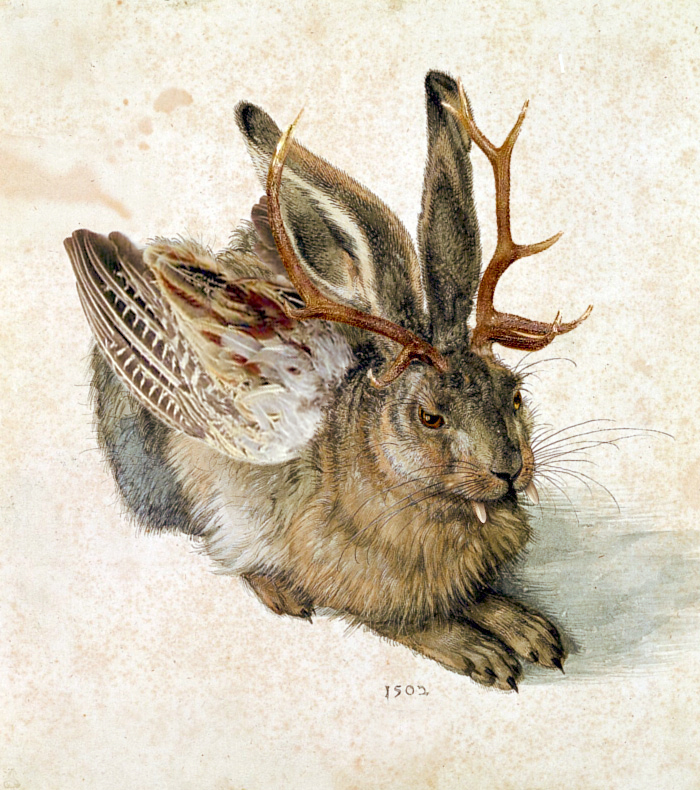
Artistic rendering of a wolpertinger by Rainer Zenz
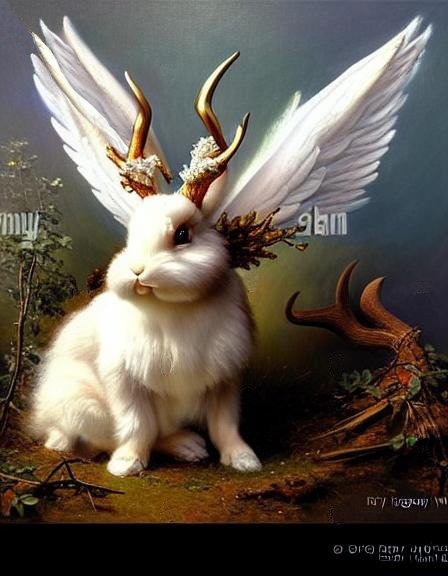
A painting of a wolpertinger doe from a Lapin manuscript, marked with a literomantic cypher by Sable Aradia with Artbreeder


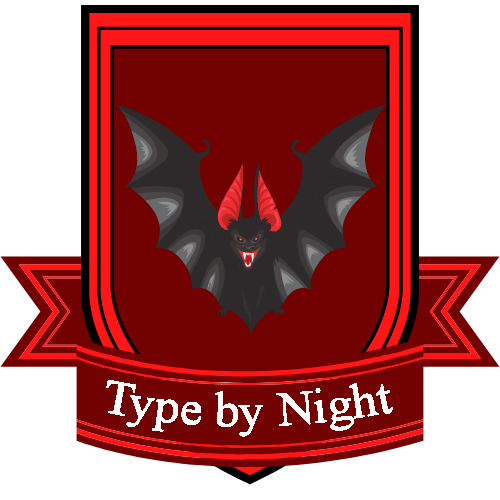

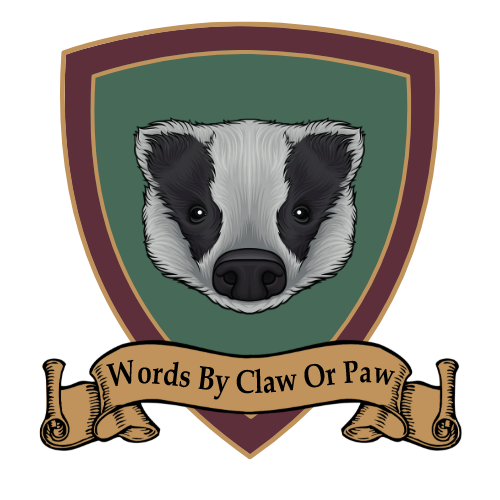


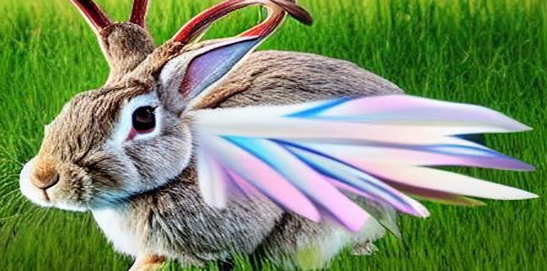




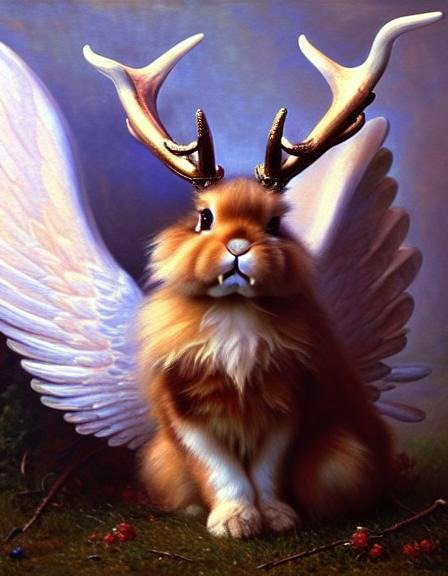
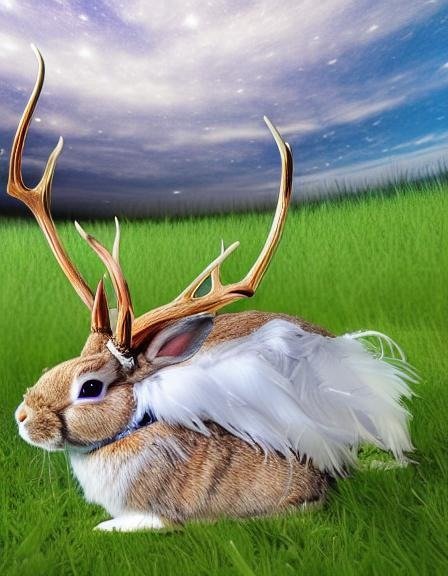
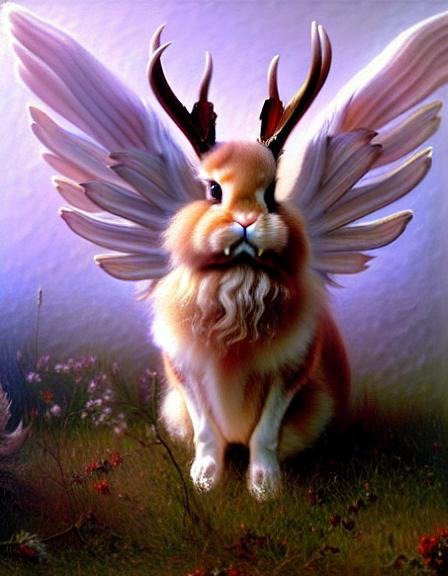
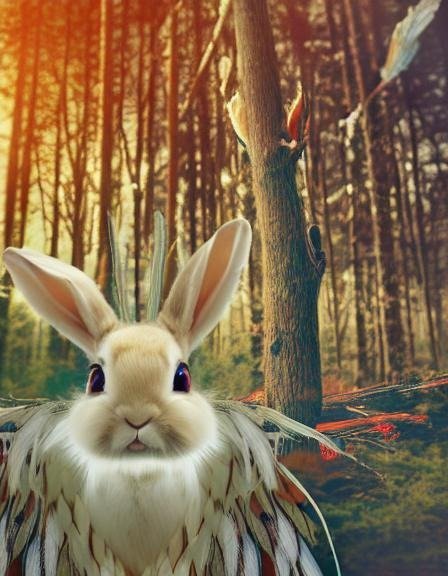

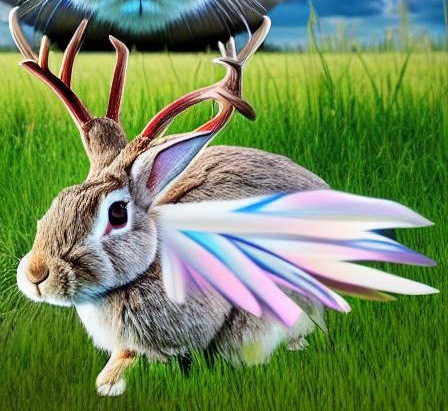



This is a beautiful creature. I would love to meet one although I’m not sure what they would make of Flubb. If domesticated I could imagine them being for sone being treated like budgies. Creatures to talk to. I have a feeling that it would be like that the females might be more likely to be indoors pets due to smaller antlers and the males kept in runs. To you think there might be a captive breeding program if they’re seen as endangered?